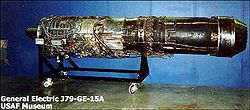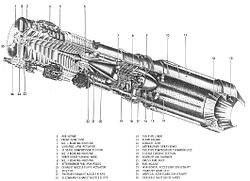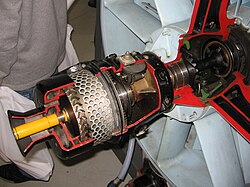Evolution of the variable stator compressor
By the late 1940s, jet engine design had progressed to the point where further progress was limited by the performance of its compressor, in particular the pressure ratio of the compressor had to be increased to reduce the engine fuel consumption. However, the useful operating range of the compressor was limited at that time and centered around its design condition which is at a high compressor speed for take-off or cruise. If designed for high efficiency at high speeds it was very inefficient and prone to stall at low speeds.
In 1944 the National Advisory Committee for Aeronautics had tested a theory for "Extending the useful operating range of axial-flow compressors by use of adjustable stator blades" by running an eight-stage axial compressor with pressure ratio 3.42:1 and adjustable blade angles. [4] Considerable improvement in efficiencies were obtained at compressor speeds appreciably below the design speed. [5]
Departures of velocity from the design condition are most noticeable in the first stages at low rpm and become more so as the design pressure ratio is increased leading to blade stall and compressor surging as happened with the Rolls-Royce Avon compressor, with design pressure ratio of 6.3:1 in 1949. In 1947 Geoff Wilde, a Rolls-Royce compressor designer, had applied for a patent "Axial flow compressor regulation" "to provide a compressor with a wide speed-range of operation". [6] An experimental 12-stage compressor was built with the inlet guide vanes and first four rows of stator blades adjustable to lower the air incidence angles while running at low speed. It was very effective in overcoming the stall and surge. However, a simpler mechanical-design solution (variable inlet guide vanes and bleed) had already been shown to work with the required design pressure ratio so variable stators were not used in a Rolls-Royce engine until the 1980s (IAE V2500). [7]
By 1950 General Electric was focusing on supersonic engines with variable stators as a result of design studies which compared them with dual-rotor types. Based on their past experience at that time, and estimation of the development effort required to prove new technologies, variable stators promised the best way of designing the compressor for the high required pressure ratio of 12:1. This pressure ratio was needed to achieve the supersonic performance, subsonic cruise performance and low weight necessary for future supersonic aircraft.
In 1951, a General Electric team led by Gerhard Neumann, at that time in charge of engine development testing, was given funding to build a test compressor with variable stators. In addition, the Aircraft Gas Turbine Division lead, C.W. 'Jim' LaPierre, formed two teams to do design studies for an engine that could run for extended periods at Mach 2.0 while still giving good fuel economy while cruising at Mach 0.9. Neumann led a team using a variable stator configuration, while Chapman Walker led a parallel effort using two-spools. After a years study the engine with variable stators was chosen as it was lighter, simpler and had a smaller diameter. [8] A demonstrator engine with variable stators, the GOL-1590, predecessor to the J79 was built. At the same time a new engine, the X-24A, was designed for a supersonic aircraft and selected by the Air Force. Development of the new engine was supported by running the GOL-1590 demonstrator engine. [9]
General
GE won the Air Force contract for a new engine with approximately 14,000 pounds-force (62,000 N), with afterburning, to power a new supersonic bomber, which became the Convair B-58 Hustler. The two other engines offered by GE, an advanced version of the existing J73 and a much larger design, known as the J77, were both cancelled. The first prototype of the production version, XJ-79, ran on 8 June 1954. [10]
The first flight of the engine was on 20 May 1955 with the engine installed in a General Electric J47-powered North American B-45C Tornado (serial 48-009). In flight the J79 was lowered from the bomb bay into the airstream for testing. [11] The first flight after the 50-hour qualification test, required for a new engine that is the sole source of thrust for a flying testbed, was on 8 December 1955, powering the second pre-production Douglas F4D Skyray, with the J79 in place of its original Westinghouse J40 engine as part of the General Electric development and qualification program. The YF-104 was the next airplane to fly with the J79 followed by a re-engined Grumman F11F Tiger in a Navy-sponsored program to gain experience with the engine before the first flight of the F4H (F-4).
The J79 was used on the F-104 Starfighter, B-58 Hustler, F-4 Phantom II, A-5 Vigilante, IAI Kfir aircraft and the SSM-N-9 Regulus II supersonic cruise missile. It was produced for more than 30 years. Over 17,000 J79s were built in the US, and under license in Belgium, Canada, Germany, Israel, Italy, and Japan. A downgraded version of the General Dynamics F-16 Fighting Falcon with a J79 was proposed as a low-cost fighter for export, and though a prototype aircraft was flown, it found no customers.
The J79 was replaced by the late 1960s in new fighter designs by afterburning turbofans such as the Pratt & Whitney TF30 used in the F-111 and F-14, and newer generation turbofans with the Pratt & Whitney F100 used in the F-15 Eagle which give better cruise fuel efficiency by-passing air around the core of the engine.
For their part in designing the J79, Gerhard Neumann and Neil Burgess of General Electric Aircraft Engines were jointly awarded the Collier Trophy in 1958, also sharing the honor with Clarence Johnson (Lockheed F-104) and the US Air Force (Flight Records). [12]







